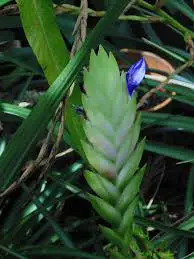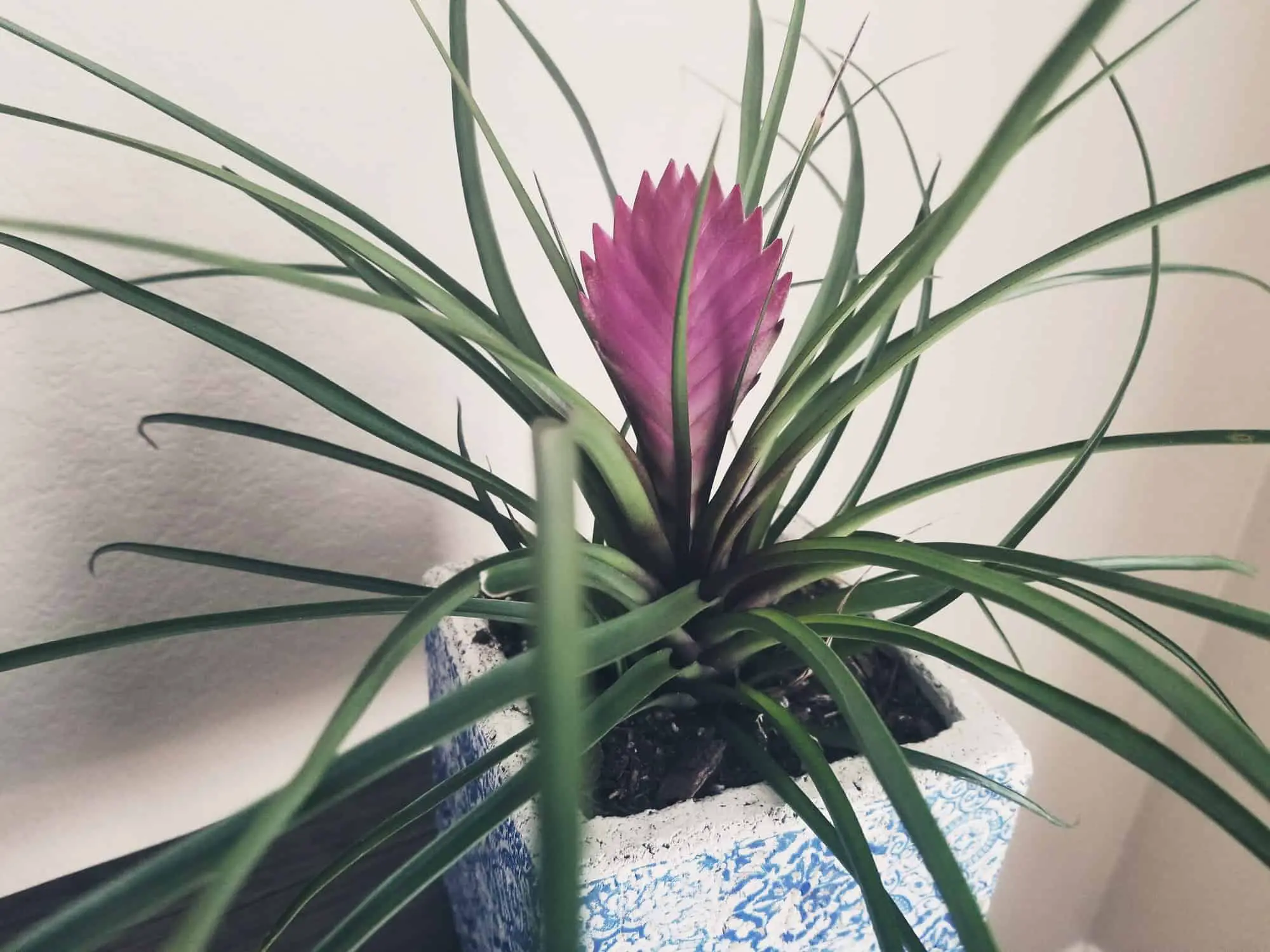The Pink Quill is an inexpensive houseplant that you can find at almost any gardening center or supermarket. Although many people only keep Pink Quill plants in their homes for a short period of time, Pink Quill live for several years after the flower head dies.
To take care of a Pink Quill, place the plant in an area that is exposed to bright, natural sunlight. Spray your Pink Quill once a week with bottled water or filtered water. These plants only need to be fertilized once or twice per year with a fertilizer made specifically for air plants.
The rest of this blog post will show you how to properly care for your Pink Quill so you can enjoy it for years to come.
About Pink Quill
Tillandsia cyanea, commonly known as Pink Quill, is a member of the bromeliad family and the Tillandsia genus. Tillandsias are commonly referred to as air plants. The Pink Quill gets its name from the characteristic pink flower head that forms when the plant matures.
These plants grow as epiphytes in Ecuador and northern Peru. This means they will grow on rocks and trees rather than in soil. They are typically found at elevations between 2,000 and 3,500 feet above sea level. In the wild, these plants grow well in a variety of lighting conditions. They can be found in the treetops where there is exposure to a lot of sunlight or under the shade of other trees.
They are hardy plants that can withstand hot and cold temperatures.
Tillandsia cyanea vs Tillandsia lindennii
As unique as Pink Quills are, they have a “look alike.” Tillandsia lindennii looks very similar to the Pink Quill, but they are a bit larger. Pink Quill will grow to a height of 10-12 inches. In contrast, the Tillandsia lindennii will grow taller than 16 inches. Tillandsia lindennii is a little more tolerant of cold than Pink Quill.
In the mid 20th century, a hybrid of Tillandsia cyanea and Tillandsia lindenni was created by D. Barry. This cross is called Tillandsia Emilie. Reportedly, the Tillandsia Emilie is more robust and easier to grow than the Pink Quill or Tillandsia lindenni.

Lighting Requirements For Pink Quill
Like most houseplants, your Pink Quill should be exposed to bright natural light. I recommend placing this plant next to an east- or west-facing window. However, you do not want to expose these plants to hot, bright light. Too much sunlight could burn the leaves.
Best Soil Mix For Pink Quill
Pink Quill is unique among tillandsias in that they prefer to be grown in a well-draining growing medium rather than epiphytically. Although, they will survive if grown epiphytically. When they are grown in soil, they will develop a robust root system.
Pink quill plants will grow well in a mixture of sphagnum moss and epiphytic mix. This growing medium allows the plant to tolerate frequent watering and extend their roots.
Alternatively, you could plant your Pink Quill in orchid bark or in a cymbidium mix.
When planting your Pink Quill plants, make sure you give them enough room to expand. It is not uncommon for these plants to produce up to 10-12 offshoots. However, this can take several years.
Watering Pink Quill
Like other species belonging to the Tillandsia genus, Pink Quill does not require much water. Simply spray your Pink Quill with water once or twice a week depending on how humid your home is and on the amount of sunlight. During the winter, cut back on the frequency of watering and only water your Pink Quill once every two or three weeks.
During the summer, water the soil thoroughly every month or two.
It is important to note that Pink Quill is sensitive to the chlorine content of tap water. If possible, water your plant with rainwater. If you do not have a rain barrel and must use tap water, leave the water out overnight in an open container. This will allow the chlorine to evaporate.
Pink Quill is also sensitive to hard water. If you frequently find calcium buildup on your shower or faucets, you probably have hard water. The minerals in hard water can block the pores of your Pink Quill which blocks their ability to absorb nutrients from the air. For this reason, I recommend using bottled water if you have hard tap water.
Fertilizing Pink Quill
Pink Quill plants do not need to be fertilized very frequently. I recommend only fertilizing these plants once or twice a year during the spring or summer.
You could use either a time-release fertilizer or a half-strength soluble fertilizer. Air plant fertilizer and half-strength orchid fertilizer are good options for feeding your Pink Quill.
In the wild, these plants extract nutrients from foliage rather than soil. For this reason, it is best to spray the leaves or soil surface with fertilizer.
When applying fertilizer to your Pink Quill, be careful not to spray the flower head.
Propagating Pink Quill
To learn how to propagate Pink Quill, it is important to understand its life cycle. The life cycle of a tillandsia can be summarized as:
- The plant grows;
- Eventually, the plant flowers. It takes Pink Quill about 4 years to flower.
- After flowering, the plant starts to die.
- The “mother plant” will begin to use nutrients to produce offshoots that are commonly known as “pups.”
- The pups will grow into plants, and the cycle will repeat.
This means that eventually, the pink flower head, as well as the mother plant, will die. Fortunately, you should be able to enjoy the pink flower head and purple flowers for weeks or even months before that process begins.
After a while, the flower head will start to change from pink to green. This is an indication that the plant is finished flowering. The flower head turns green because the chlorophyll overtakes the red pigments.
The flower head (quill) will remain green for a couple of months and eventually turn yellow or brown. At this point, you should remove the rotting quill. If the flower head remains attached to the plant, it will continue to take up nutrients from the healthy parts of the plants.
Then an offshoot plant, called a pup, will start to appear. This may take a couple of months. Once the pup is about 50% of the size of the mother plant, you can remove the pup from the mother plant. If you want the pup to mature as quickly as possible, it is a good idea to keep the pup attached to the mother plant.
However, if you want to produce as many pups as possible, it is a good idea to remove a pup from the mother plant as soon as it is large enough. Although the pup will not mature as quickly, the mother plant will produce more pups.
How to Remove Pups
Removing pups from the mother plant can be tricky if you have never done it before. When removing a pup from the mother plant, it may be best to use garden clippers. Simply cut the pup as close to the mother plant as possible. The pup may not have roots yet, but roots will form quickly if placed in the proper potting mix.
If you do not have garden clippers or scissors available, you can also hold the mother plant with one hand and pull the pup with the other hand. Apply side-to-side pressure in order to remove the pup, and it should pop right out. If the pup breaks off too far away from the mother plant, you can try saving it by dipping the end in some rooting hormone. Allow the end to callous over before attempting to plant the pup.
Once you have removed the pup, plant it in a small pot of well-draining soil. Make sure you provide the plant with enough light and keep the soil moist.
Is Pink Quill Toxic?
Based on what I have read, Pink Quill is not toxic to cats or dogs. However, I have also read that cats enjoy chewing on the leaves of the Pink Quill. Although Pink Quill is not toxic, you should discourage your pets from chewing on the leaves. Not only is this not good for the plant, but it also may not be particularly good for your pet.

